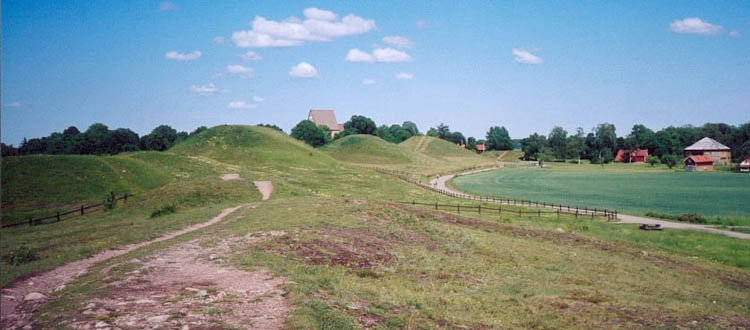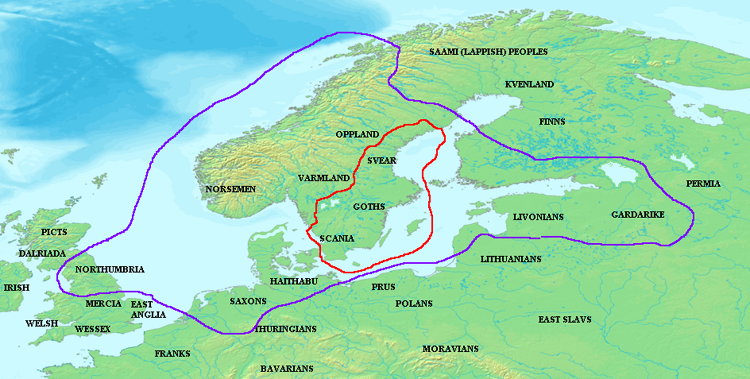Sweden
Sweden was relatively remote and therefore conservative. It was the last Germanic territory to be converted to Xianity and continued using runes centuries
longer than other places. And although heathenry differed from place to place, the evidence from Sweden is noticeably different in several ways.
Modern Sweden coalesced starting in heathen and early medieval times out of several independent kingdoms with varying borders.
Firstly, the region around Scania (Skĺne) was historically independent and became part of Denmark (the so-called "Eastern Province") before it became
Swedish. In fact Scania, Zealand, and Jutland were the three states that came together to form Denmark in the early 9th century; the name "Denmark" itself
comes from the "frontier" of the western and southern coast of what is now Sweden and originally meant only that region; and the archdiocese of Denmark was
established on the island, at Lund, in 1104. In the 14th century, the Scania region briefly became part of a unified kingdom with Norway and Sweden; Sweden
and Denmark clashed there repeatedly from the fifteenth century onwards and except for the island of Bornholm and a small adjacent island, which won the
right to go back to Denmark, the territory has been officially part of Sweden since the Treaty of Roskilde in 1658, but there was strife including battles
until 1811, when Scanian peasants rebelled against fighting in the Napoleonic Wars.
Secondly, the island of Gotland and the nearby provinces of West Gotland and East Gotland (Västergötland and Östergötland) may have been originally
populated by East Germanic-speaking Goths, or the "Geats" as Béowulf calls them may have been a different people. Uppland and Värmland were also originally
independent. The land of the Svear (Swedes) proper, centered on Uppsala and Lake Mälaren, was originally ruled by Yngling kings (Norse Ynglingar), who were
said to descend from Yngvi-Freyr. Heimskringla tells the stories of a long line of them; starting with Egil in the late 5th and early 6th centuries C.E.,
they are mentioned also in Béowulf (where he is Ongenţeow). The last Yngling king was probably Ingjald, who was succeeded by Ivar Vidfamne (Ívarr inn
víđfađmi - Ivor the wide-armed) in about 655; however Saxo Grammaticus says that Sigurd Ring, who ruled from about 750 to 770, was also of the Yngling line.
Historians are dubious about the historicity of the early kings of the Svear and give full credence only to Eric the Victorious (Eiríkr inn sigrsćli, Swedish
Erik Segersäll, 970-95) and his successors.
The great heathen temple at Uppsala (today's Gamla Uppsala) was famous far and wide. We have allusions to it in three sources. Heimskringla says Freyr made
his abode there and set up the temple, and recounts that King Domaldi was sacrificed there after the harvest failed, and that some later kings sacrificed their
sons there. Saxo also says Freyr resided there, and blames him for instituting human sacrifice there in place of animal blót. He also insinuates that the
priests at the ceremonies in Uppsala were effeminate in their gestures and use of bells. The greatest source of information is contemporary with the struggle
to completely convert Sweden: Adam of Bremen's History of the Diocese of Hamburg-Bremen of the second half of the 11th century and some explanatory notes or
scholia in it. Here the temple is described as a large, magnificent building with a golden chain around the eaves, standing on a plain surrounded by mounds
(which remain at Gamla Uppsala with a small Xian church nearby on the site of the temple), and with a gold-bedecked interior in which were three god-images:
in the center on a throne Thor and on either side of him "Wotan" and (with a giant phallus) "Fricco." Near the temple was a well in which human sacrifices
were made, and a tree of unknown species that was always green, and from whose branches sacrifices were hanged: every ninth year at the spring equinox, a great
festival was held that all Svear had to attend and every day for nine days, nine creatures were hanged, including men (de Vries 1, 420).
Opinions vary as to when Götaland, the land of the Goths or Geats, was combined with the land of the Svear; some would say as late as the 12th century.
There was a long period of rivalry between dynasties rooted in one or the other. The island of Gotland, in particular, was culturally very different. Rather
than runestones embellished with pictures, it has picture-stones, in a characteristic shape that can be described as like a keyhole or a mushroom. They feature
valknuts, valkyries welcoming heroes into Valhalla, and Óđinn riding Sleipnir, and one of the names of Óđinn is Gautr, so heathenry in Götaland seems to have
been particularly Odinic, in contrast to the derivation of the Uppsala kings from Yngvi-Freyr. Here again we hear of human sacrifice; Guta Saga says the
Gotlanders used to sacrifice their own sons and daughters (De Vries 1, 409).
Because of the uneasy alliance of formerly independent kingdoms under the Swedish throne, at some point the custom developed that after being chosen king at
the Stones of Mora (in a meadow about 10 km from Uppsala, an ancient thingstead and equidistant from two others), the lucky man must ride a prescribed route
around the whole kingdom before being allowed to reign. This was called the Eriksgata, which may derive from the literal meaning of the name Eric, "single
ruler." If he survived, he had obviously demonstrated enough support and luck to do so, especially since he had to be hailed by the lawspeakers of every thing
on the way. Sometimes he did not survive: in 1126 Ragnvald Knaphövde (either "round-head" or "head-sized alecup") dissed the West Gotlanders, who supported a
rival candidate from Denmark, by declining to take hostages from local clans with him on that portion of his ride, and was slain.
West Gotland was the beachhead for the introduction of Xianity into Sweden. According to Adam of Bremen Eric the Victorious was baptized in Denmark but
returned to heathenry; his successor Olof Skötkonung, the first Swedish king to remain Xian, was supposedly baptized at Husaby, near lake Vänern, in either
1000 or 1008 but had to restrict his Xian activities to that province, which had already converted. He could only grumble about the great temple at Uppsala.
However, the distinct geographic entities at the time, the overall independence of the people, and intractable rivalries between archdioceses with conflicting
claims to sole representation of the North or control over countries within it all make the conversion of Sweden a complex and protracted story. In 827 or 829,
Ansgar (later Archbishop of Hamburg and then of Hamburg-Bremen and subsequently canonized) was sent by the Frankish King Louis the Pious to preach to the
Svear, reportedly at the request of King Björn at Haugi ("at the barrow"), and formed a small congregation at Birka that included the king's steward Hergeir.
But when he returned around 850 he found it had foundered. Olof Skotkönung's illegitimate son King Emund den gamle (Eymundr gamle, "the old," also dubbed
Ćmunđćr slemć (modern slemme), "the bad," by the Swedish chroniclers for opposing the influence of Bremen and its archbishop, Adalhart, and preferring an
English missionary) was already Xian when he ascended the throne; by the time of his son-in-law and successor King Stenkil (Steinkell) (1060-66), heathenry was
almost confined to Uppsala, but the king refused to let Adalhart destroy their god images as he had those in West Gotland. Sweden was finally officially
converted under the ironically named King Inge (Ingi Steinkelsson; probably identical with Saxo's "Anund Gĺrdske"), who refused to blót the gods at Uppsala and
was thus overthrown in 1084 when his brother-in-law Sweyn (modern Sven) stepped up and did so, becoming Blót-Sweyn. Inge went into exile in West Gotland. But
three years later, in 1087, he entered Uppsala with a great force, set fire to King Sweyn's house, and killed him as he came out. It is likely that this is
also when the great temple was destroyed. Although Blót-Sweyn was the last heathen king, the Church of Sweden was only fully organized some 70 years later,
under Eric the Saint (1150-1160, also called Eric the Lawgiver or Eric IX); for good measure legend recounts that he also led a Crusade with Bishop Henry of
Uppsala to convert the Finns.
.JPG)
Photo by Berig, Wikimedia Commons
A Gotland stone

Photo by OlofE, Wikimedia Commons
The royal mounds at Old Uppsala, with the church on the site of the great hof behind them

Map created by Briangotts, Wikimedia Commons
Map of territories ruled (red) and taxed (purple) by King Ivar Vidfamne, showing the separate regions that became modern Sweden.

Map created by Ningyou, Wikimedia Commons
Another clear map of the Geat and Svear territories.
See also: a page on Gotland stones (will open a new window).
[1. Gotland stone image from http://en.wikipedia.org/wiki/File:Hammars_(I).JPG
2. Burial Mounds at Old Uppsala image from http://en.wikipedia.org/wiki/File:Gamla_uppsala.jpg
3. Territories ruled by King Invar Vidfamne image from http://en.wikipedia.org/wiki/Image:Ivar.png
4. Geat and Svear territories map image from http://en.wikipedia.org/wiki/Image:Scandinavia-12th_century.png]
